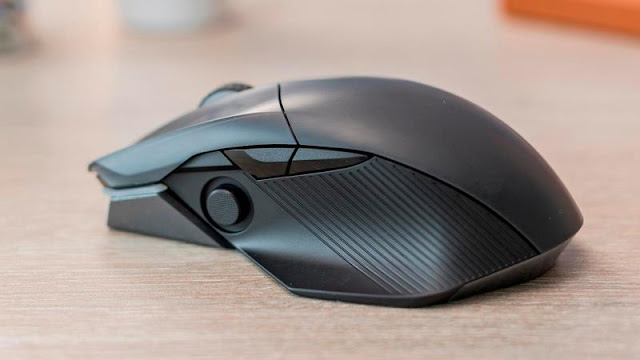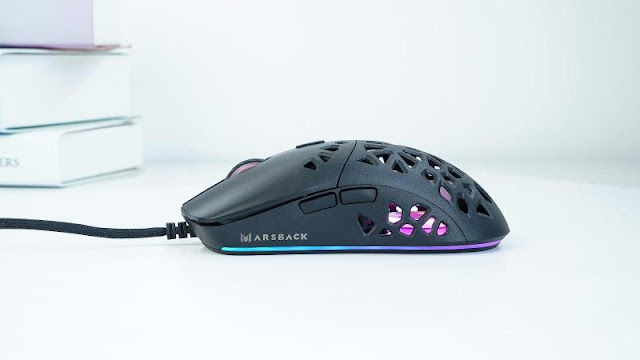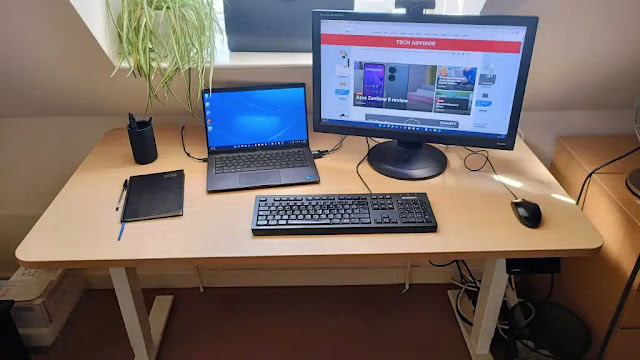Whether you're mowing down your opponents or demolishing those Microsoft Excel spreadsheets, it's essential that you have the right mouse under your hand. Gaming mice, in particular, have a seemingly endless variety of options to choose between, all offering different benefits.
1. Razer Naga Trinity
- Swappable side plates
- Suited to multiple game types
- 16,000 DPI
Cons
- Designed for right-handed players
$99.99
Improving on one of the best gaming mice available, Razer’s Naga Trinity offers the best of the Hex V2 and then some. Why? While many gaming mice offer a single setup, the Trinity, as the name suggests, offers three. The mouse sports an interchangeable side plate and includes 2-, 7- and 12-button plates in the box, allowing you to customise the mouse for the type of game you’re playing. It’s simple to do too, and uses a magnet to snap the plates into place.
It’s not just a gimmick either – each plate features high-quality buttons that provide tactile feedback with every click, and ergonomic placement means we’re yet to experience any misclicks – even with the 12-button plate. This brings a huge advantage to PC gamers, as it provides up to 19 programmable buttons to be used in your favourite games, all customisable via the Razer software.
Along with the ability to switch out button plates, the Razer Naga Trinity offers an impressive 5G optical sensor with up to 16,000DPI (although we were content in the 1200s) to provide the sensitivity and speed required to beat the best when gaming online.
The design isn’t too in-your-face either, which is a refreshing change for gaming mice that are usually covered in LED lighting. Don’t get us wrong – you still get some areas lit by customisable LEDs (the logo, scroll-wheel and buttons), but it’s much less distracting than others we’ve seen. It is favoured for right-handed players though, which may cause issues with lefties.
2. Logitech G502 Lightspeed Wireless
- Great wireless performance
- Lightweight design
- 16,000 DPI
Cons
- Premium price tag
- Two-day battery life
$149.99
Logitech’s G502 Lightspeed Wireless features slick design and impressive internals to deliver a premium gaming experience, complete with hotkeys and lag-free wireless connectivity. That wireless connectivity is powered by Logitech’s proprietary Lightspeed tech, providing low-latency 1ms response times to make sure you can react to crucial in-game moments in the blink of an eye.
It keeps the lightweight form factor of the hugely popular G502 HERO, weighing in at 114g, and boasts the same five customisable buttons near the grippy thumb rest on the left of the mouse. The G502 Lightspeed Wireless also sports the HERO 16K sensor, and is capable of tracking speed across the entire 16,000 DPI range. You can quickly tweak the current DPI using the easy-access buttons, ideal for switching between scope and no-scope in multiplayer shooters.
The scroll wheel has two modes - ratchet and free scroll - providing clicky tactile feedback for precise scrolling and lightning-fast, resistance-free scrolling experience respectively. The scrolling mode can be changed on-the-fly via the dedicated toggle found just beneath the scroll wheel itself, making the mouse ideal whether you’re selecting a weapon from your scroll wheel inventory in your favourite shooter or scrolling through long documents at work.
In terms of battery life, the G502 Lightspeed Wireless manages around 48 hours on average with the RGBs enabled, and jumps up to around 60 hours with lighting disabled. If the idea of plugging it in doesn’t appeal, you can pick up the optional Powerplay wireless charging mat and keep the mouse topped up without the need for a USB cable.
3. Asus ROG Chakram
- Built-in analogue stick
- Multiple connectivity options
- Great performance
Cons
- Analogue stick placement isn't perfect
- Premium price tag
$149.99
Most gaming mice lean into a specific strength. Maybe it's DPI, maybe it's customisability, maybe its wireless performance or battery life or any number of other things. The Asus ROG Chakram does its best to lean into every possible strength at once.
Listing this flagship mouse's specs and features it almost exhausting. You can use it wired over USB, or over either Bluetooth or 2.4GHz wireless.
The 16,000 DPI sensor is top of the line, and a DPI button on the underside lets you adjust responsiveness on the fly.
There are three RGB light zones: underneath the main buttons, the scroll wheel, and an ROG logo under your palm. This is actually customisable though - you can lift the case up and remove the logo plate to swap it with the included blank version, which you can customise how you see fit - so long as you have a steady hand and some artistic flair.
That's not all you can tweak. Obviously, all the buttons are remappable and the lighting works with Aura Sync, but you can also swap out the mouse switches to replace damaged ones or simply adjust the feel to suit your playstyle. All of this can be done without a screwdriver or other tools.
What about the other buttons? In addition to two side buttons there's a built-in joystick (again, customisable, with multiple sizes included). You can use this either in a digital mode that maps the four directions to specific inputs (to reload, lean around a corner, etc.) or in an analogue style to properly replace a thumbstick for flight sims or racing games.
It works well, and my only real complaint is that it's a little further forward than I'd like, so that the way I naturally hold the mouse leaves my thumb just shy of the stick. Once you get used to having the extra four inputs from the digital mode it's hard to go back (for regular use, not just gaming) and a thumbstick is a much more natural implementation than having four extra buttons, though the analogue functionality will no doubt prove a little more niche.
With all this tech, battery life should suffer right? Not so. Asus says the Chakram will last 79 hours over 2.4GHz (without the RGB lighting, to be fair) and I've found the battery lasts days of use comfortably. Fast USB-C charging gets you hours of charge from 15 minutes plugged in, while slower Qi wireless charging is a convenient back-up.
It's also not cheap. But you are getting so much in return that it's honestly hard to argue with the price, and you could pay almost as much and get a whole lot less elsewhere.
4. HyperX Pulsefire Dart Wireless
- Impressive battery life
- Ergonomic design
- Wireless charging
- Disappointing PC software
- Right-hand users only
$99.99
The Pulsefire Dart mouse from HyperX is responsive and fast, coming with a triple threat of 2.4GHz wireless connectivity, a 1ms response rate and RF technology to boost the wireless signal – which results in no latency or lag during testing. Internally the Pulsefire Dart houses a Pixart 3389 sensor, along with five customisable DPI settings and up to 16,000 native DPI for complete accuracy during fast paced games.
The best thing about the mouse is its comfortable design, thanks to the ergonomic leatherette grips along the sides which avoids any aching on your palm during long gaming sessions. There are two buttons on the left side that are customisable to suit your preferences - but that does mean that the Pulsefire Dart is geared towards right-hand users. The mouse also boasts LED lighting, but it's quite minimal – in-keeping with an overall design that is less rugged and flashy than rivals.
Battery life is great as well – HyperX predicts around 50 hours with lighting on, which we found to be accurate, but this can be extended to a whopping 90 hours without the lights. The Pulsefire Dart can be used either wireless or wired via the USB-C cable, which doubles as a charging lead. You can also pair this device with the wireless Chargeplay Base from HyperX, though this does slow down the charging process.
One large let down of this device is the accompanying NGENUITY software for Windows. This is designed to customise the lighting, but we struggled get it to pair with the device and the overall user experience is clunky and slow. Nonetheless, with a comfortable yet refined design, rapid performance and a battery life that’s not to be sniffed at – the HyperX Pulsefire Dart is an all-round wireless/wired hybrid contender in the gaming mouse space.
5. Mad Catz R.A.T. 6+
- Hugely customisable
- Unique design
- Reprogrammable buttons
Cons
- 12,000DPI
- Designed for right-handed gamers
$79.99
Looking like a cross between a Scrapheap Challenge submission and Michael Bay’s Transformers, the Mad Catz R.A.T. 6+ is one of the most outlandish looking peripherals in this lineup but don’t mistake its aesthetics for a parts-bin creation.
The R.A.T. 6+ is an impressively-customisable gaming mouse, both in terms of hardware and software. It features an adjustable palm rest that means it’s versatile enough to accommodate palm, claw or tip-grip styles comfortably, while a trio of six-gram weights can be removed or added to suit your preference (standard weight sits at 120 grams total).
The general layout of the design, right down to the offset braided cable means the R.A.T. 6+ was definitely built with right-handed users in mind, so lefties are better served by some of the other offerings in this roundup.
The combination of matte and shiny plastics across the mouse’s visible faces won’t be to everyone’s tastes and we’d opt for the white over the black model because of this, but you do get a sturdy metal chassis with PTFE feet for a smooth glide.
The thumb rest is a nice inclusion that helps with movement and lets you get at the hardware controls on the mouse’s left side. You’ll find a total of 11 programmable buttons across the R.A.T. 6+’s bodywork, including a DPI shifter and a profile switcher on top, as well as a precision DPI button on the side, which ideal for in-game actions like sniping or fine detail work on graphic design projects, for example.
With a maximum 12,000DPI from the ever-popular PixArt PMW 3360 sensor running the show (plus support for up to 50g acceleration), most FPS and MOBA plays should be able to operate within the limits of the R.A.T. 6+’s capabilities.
Along with the mouse's physical customisation, through the included software you can also reprogram practically every button, adjust attributes like poll rate, correct for angle snap, lift-off and wrist orientation, and personalised the R.A.T.'s 3 LED zones in terms of both colour and pattern.
6. Asus ROG Spatha
Cons
- Expensive
- 8,200DPI
$179
The Asus ROG (Republic of Gamers) Spatha sports a completely new design with a rather detailed Mayan-style grip on the left hand side next to six fully programmable thumb buttons, ideal for use in MMOs and MOBAs alike.
There aren’t only six buttons though – there are twelve buttons across the mouse ready to be customised via the ROG Armoury software available for Windows. That’s only touching the surface with regards to the app, as it also lets you customise button response, polling rate, acceleration, angle snapping and more, perfect for pro gamers.
The magnesium alloy-constructed ROG Spatha boasts extremely high sensitivity, thanks to the use of an 8200dpi laser sensor coupled with a DPI switch. As well as this, the ROG Armoury offers surface calibration, providing you with the best performance for the surface it’s being used on.
This combination allows you to switch between high and low sensitivity with a single click while giving you finer control when aiming with a precise weapon like a sniper rifle, for example.
If that’s not impressive enough for you, then maybe this is: the Asus ROG Spatha is both wired and wireless, depending on your personal preference. You can use the supplied Micro-USB cable to connect the mouse to your PC, or alternatively, you can connect the receiver/charging station and use it wirelessly until it requires a charge. It gives users the freedom to play how they like without having to compromise.
Along with the above features, it comes with fairly standard LED customisation that lets you change not only the colour of the logo on the mouse and scroll wheel, but also the light that leaks out between the thumb buttons along the left-hand side of the mouse.
7. Marsback Zephyr Pro
- Built-in fan
- Great honeycomb design
- Affordable
Cons
- Comfort issues
- Fan angle adjustment isn't noticeable
- Right-handers only
$59.00
The Zephyr Pro RGB Gaming Mouse from Marsback is a USB wired peripheral for anyone who wants to keep their hand cool during long gaming sessions. It comes in a choice of two colours – black and white – with an aesthetically pleasing honeycomb design, as well as customisable RGB lighting. There are two left-hand buttons, making this mouse best for right-handed users.
The mouse comes equipped with a Pixart 3389 sensor, as well as 400 IPS and up to 16,000 DPI. The mouse can also allegedly take up to 50 million clicks, meaning it should stand the test of time. I found it to be fast and accurate during gaming and had no major issues with movement.
The design is comfortable for long periods of time – though it’s not completely ergonomic like some other rivals. The addition of the fan does keep my hand cool throughout sessions, but it isn’t massively powerful. You can use the fan button to change the angle of it from 45° to 180°, but personally, it doesn’t feel like it makes a difference. However, the device is extremely quiet, producing just 30 decibels of sound.
The mouse works with the custom Marsback software, which you can use to assign keys different functions (such as opening your email), new lighting patterns, alter the speed and DPI settings and more. This is easy to download and install, and all features are well labelled and work without a hitch.
Overall, this is a competitive wired option that looks good, and has the side benefit of stopping your palm from getting sweaty.
8. Roccat Kain 120 Aimo
- Durable
- Simplistic design
- 16,000DPI
Cons
- Too large for long gaming sessions
- Limited RGB lighting
- Limited customisable buttons
$69.99
It might look a little on the basic side, but the devil is in the detail with Roccat’s Kain 120 Aimo. From the super-flexible braided cable to the Pro-Grip coating and refined (and very satisfying) click mechanism that’s rated for 50 million actuations, everything about the Kain 120 Aimo has been carefully and thoughtfully designed for gamers.
There’s a choice of black or white models (the white one is called the 122), and compared to its sibling, the Kone Aimo, there’s just two RGB zones: one under your palm and the other in the scroll wheel. That means the LEDs aren’t distracting while you game, and you can adjust brightness and colour for each zone in the Swarm software.
It’s there that you can also adjust the DPI settings: from 50 up to 16,000 DPI thanks to Roccat’s latest Owl-Eye sensor. You can have up to five preset DPI levels, each of which is identifiable by a different colour in the scroll wheel as you toggle through them using the DPI switch.
If you’re not sure which is the best setting, a useful Calibrate button gets you to move the pointer to targets as quickly as possible. Typically you’ll want it at a far lower setting than 16,000, though.
As you’d expect, you can also assign the buttons to whichever function you want, but unlike many gaming mice, there aren’t that many of them: the only extras are two buttons on the side which default to back and forwards in a web browser.
We found the Kain a little too large to be really comfortable for long gaming sessions, but ergonomics are such a personal thing, and it may well be ideal for you. Roccat says the design is the result of two years of research and testing, and says it doesn’t “strictly position your hand into a specific grip style”.
There are actually three models in the range. The 100 uses a lower-resolution sensor and costs £39.99, while the wireless 200 is £89.99.
9. Nacon GM-180
- Very affordable
- Low-profile design
- Customisable buttons
Cons
- Low 2200DPI
- Needs AA batteries
- Spotty wireless performance
$19.90
The Nacon GM-180 is a very basic wireless gaming mouse, but it's much more capable than you might expect for the price.
For starters, you get an impressive 30-hour battery life - though note that this is powered by a single AA battery, and so it's not rechargeable.
The DPI is adjustable on the fly, with four sensitivity settings ranging from 800 up to 2200. That's a relatively low max DPI, so this certainly won't suit pro players, but it'll do for many.
There's RGB lighting, with both the scroll wheel and the Nacon logo lighting up and changing colours. Unfortunately you can only turn the lights off or on, and get no other control of the colours or timing.
It's a fairly small, low-profile mouse, so it'll suit smaller-handed players best. That also means it's a great back-up travel mouse though, since it's pretty compact and has an internal storage slot for the wireless dongle.
Button-wise, it's just the normal three buttons, plus two side buttons, and the DPI adjusters. Thanks to the side buttons, the GM-180 isn't ambidextrous.
Unfortunately I found the wireless connection dropped off once every now and then, requiring me to plug the mouse in via the included Micro-USB cable to get it going again. That and the low DPI keep me from whole-heartedly recommending the GM-180, but if your budget's tight and you know you want to go wireless, you could do much worse than this.
10. SteelSeries Sensei 310
- Ambidextrous design
- Impressive sensor performance
- Lightweight form factor
Cons
- No extra buttons
- Wired-only connectivity
$59.99
For those looking for something a little cheaper than the Steelseries Rival 700, we present the Steelseries Sensei 310. It doesn't feature the OLED display or built-in vibration motor, but it does boast an ambidextrous design ideal for those lefties out there.
It also boasts what Steelseries calls 'the world's first true 1:1 eSports sensor' up to 3,500CPI. More specifically, the Sensei 310 features a 12,000CPI PixArt TrueMove 3 optical sensor, providing incredibly accurate tracking, whether it be small adjustments or huge sweeping movements. Moving a distance on the mouse results in that exact same distance on screen with no kind of jitter.
Beyond the sensor, the Sensei 310 is impressively light at 92.1g, which when coupled with silicone side grips and fibre-reinforced plastics provides a comfortable gaming experience, even when you're clicking away for hours at a time.
And, in true Steelseries fashion, you can customise the LEDs and button mappings of the mouse via SteelSeries Engine. It'll all be saved on a 32-bit ARM processor, meaning you can switch PCs without having to install Steelseries Engine to load your presets.
What to consider when buying a gaming mouse
A lot of what to consider comes down to personal choice - how it feels in your hand, and whether you find the positioning of the buttons comfortable. Incidentally, lefties should take note; most featured here are almost entirely right-handed mice, with the SteelSeries Sensei 310 being the only ambidextrous model mentioned, so you might want to consider that before splashing out.
However, aside from sheer ergonomics, there are other factors to consider. Many mice offer adjustable on-the-fly DPI settings, allowing you to change your mouse's sensitivity at the touch of a button. This is for when you need granular control, like when you're going for that perfect headshot in a heated multiplayer game.
Only three buttons on your current mouse? Most gaming mice come with anywhere from five to ten programmable buttons (which you can assign to specific functions such as sprinting, crouching or reloading), while an MMO-style mouse might cram 20 or more onto its chassis. These can give you a leg up on the competition when used correctly.
Many also offer various backlighting options to make them more attractive to look at. Occasionally a mouse comes with removable weights, allowing you to make the mouse heavier or lighter until you’ve found your “perfect” weight.
Wired vs wireless is another consideration. Most of the mice featured here are wired, in part because there are substantially more wired gaming mice on the market. Sticking with wired saves you from worrying about battery life and guarantees a lightning-fast connection, but wireless mice are undeniably convenient and save you from messy cords. It's also worth noting that wireless connection speeds are constantly improving, so latency is becoming less and less of a concern.
Whatever you're after, whether you're a twitch-gaming fanatic looking for the perfect precision headshots or a MOBA gamer trying to maximise your DPS, there's a mouse that'll suit your needs, and after finding it, you'll never go back.


























0 comments:
Post a Comment